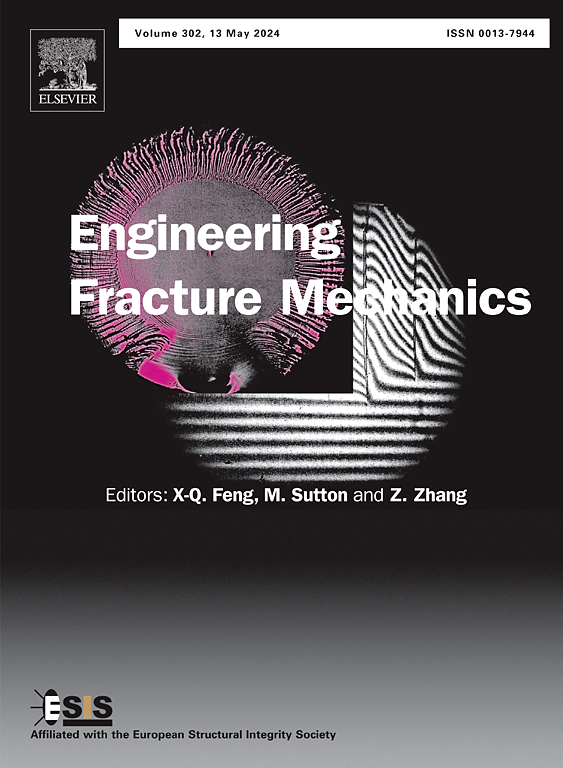加载速率升高对德国 RPV 钢主曲线(ASTM E1921)形状的影响
IF 4.7
2区 工程技术
Q1 MECHANICS
引用次数: 0
摘要
主曲线法(ASTM E1921)主要针对准静态测试条件,通过实验评估材料随温度变化的断裂韧性。ASTM E1921 附件 A1 和 ASTM E1820 附件 A14 对加载速率升高的处理进行了说明。本文介绍了对符合标准的大型数据库进行评估的结果,以验证标准推荐的加载速率升高的程序。测试涉及 RPV 钢 22NiMoCr3-7 的 C(T)-和 SEN(B)-试样(A508 2 级),加载速率为 100 MPa√m/s ≤ K̇ ≤ 104 MPa√m/s,处于韧性到脆性的过渡区域。虽然发现了有效的 T0 值,但观察到单温 T0 值与多温 T0 值的差异比预期的要大,这不能用主曲线的不确定性来解释。主曲线的形状和基本分布随着加载速率的增加而出现偏差。形状系数 p 根据单个数据进行了优化,并随 K̇ 值的增加而增加,但偏差并未完全消除。这可能与分布的变化有关,最小断裂韧性 Kmin 的优化证明了这一点,它随温度的升高而增大。有观点认为,观察结果的原因与加热过程和局部裂纹捕获有关,这严重影响了宏观断裂行为。此外,在实际应用中,由于材料的依赖性,单独调整 p 或 Kmin 也无济于事。建议在接近或低于 T0 的条件下进行高加载速率下的断裂力学测试,以尽量减少动态加载条件对评估的影响。本文章由计算机程序翻译,如有差异,请以英文原文为准。
Impact of elevated loading rates on the shape of the Master Curve (ASTM E1921) for a German RPV steel
The Master Curve Methodology (ASTM E1921) experimentally assesses a materials temperature-dependent fracture toughness, predominantly for quasi-static testing conditions. The treatment of elevated loading rates is described by the annex A1 of ASTM E1921 and A14 of ASTM E1820. This paper presents results of the evaluation of a large and standard-conforming database in order to verify the procedures recommended by the standard for elevated loading rates. Testing involved C(T)- and SEN(B)-specimens of the RPV-steel 22NiMoCr3-7 (A508 Grade 2) for loading rates of 100 MPa√m/s ≤ ≤ 104 MPa√m/s in the ductile to brittle transition region. While valid T0-values were found, single-temperature T0-values were observed to differ more than expected from multi-temperature T0-values, which cannot be explained by the Master Curve uncertainty. The shape and underlying distribution of the Master Curve show deviations with increased loading rate. The shape factor p is optimized with respect to the individual data, and it increases with , but deviations are not completely overcome. This can be linked to a change in distribution, which was demonstrated by an optimization of minimum fracture toughness Kmin, which increases with temperature. It is argued that the cause for the observations is linked to both heating processes and local crack arrest that severely influence macroscopic fracture behavior. Also, an individual adjustment of p or Kmin is not helpful due to the material-dependency in practice. It is recommended that fracture mechanics testing at elevated loading rates is performed close to or below T0 in order to minimize the influence of dynamic loading conditions on the assessment.
求助全文
通过发布文献求助,成功后即可免费获取论文全文。
去求助
来源期刊
CiteScore
8.70
自引率
13.00%
发文量
606
审稿时长
74 days
期刊介绍:
EFM covers a broad range of topics in fracture mechanics to be of interest and use to both researchers and practitioners. Contributions are welcome which address the fracture behavior of conventional engineering material systems as well as newly emerging material systems. Contributions on developments in the areas of mechanics and materials science strongly related to fracture mechanics are also welcome. Papers on fatigue are welcome if they treat the fatigue process using the methods of fracture mechanics.

 求助内容:
求助内容: 应助结果提醒方式:
应助结果提醒方式:


